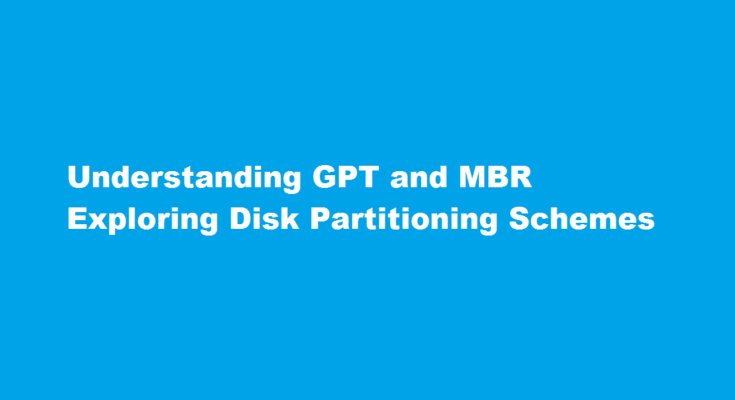Introduction
In the realm of computer storage, disk partitioning plays a crucial role in organizing and managing data effectively. Two commonly used partitioning schemes are the GUID Partition Table (GPT) and the Master Boot Record (MBR). Understanding these partitioning schemes is essential for system administrators, technicians, and even everyday computer users. In this article, we will delve into the basics of GPT and MBR, explore their differences, and discuss various methods to view and interact with these partitioning schemes.
GPT The Modern Partitioning Scheme
The GUID Partition Table (GPT) is a modern disk partitioning scheme that has largely replaced the older Master Boot Record (MBR) scheme. GPT provides several advantages over MBR, such as support for larger disk sizes, more flexible partitioning options, and improved data redundancy through the use of backup partition tables. GPT also supports up to 128 primary partitions, whereas MBR is limited to only four primary partitions.
To view GPT partitions on a Windows system, you can use the built-in Disk Management utility. Press the Windows key + X and select “Disk Management” from the menu. In the Disk Management window, you will find a list of disks along with their corresponding partition layouts, including GPT partitions.
MBR The Legacy Partitioning Scheme
The Master Boot Record (MBR) partitioning scheme has been widely used in older computers and legacy systems. It is a simpler partitioning scheme compared to GPT but has its limitations. MBR can only address up to 2 terabytes of disk space and supports a maximum of four primary partitions.
To view MBR partitions on a Windows system, you can again use the Disk Management utility as mentioned earlier. However, if you require more advanced functionality, you can utilize third-party tools like EaseUS Partition Master or MiniTool Partition Wizard. These tools provide comprehensive partition management options and allow you to view, modify, and create MBR partitions with ease.
Additional Tools for Viewing GPT and MBR
In addition to the built-in Windows Disk Management utility and third-party tools, there are other command-line and graphical tools available for viewing GPT and MBR partitions.
On Windows, you can use the command-line tool “Diskpart” to interact with partitions. Open the Command Prompt or PowerShell and type “diskpart” to launch the tool. Then, use the “list disk” command to view the disks and their partition styles (GPT or MBR). Further, the “list partition” command will display the partitions along with their details.
For Linux users, the “fdisk” command is commonly used to view and manage disk partitions. Typing “sudo fdisk -l” in the terminal will display the partition information for all connected disks.
FREQUENTLY ASKED QUESTIONS
What is the most common GPT or MBR?
A choice of MBR or GPT depends on the number of partitions one wants to create. MBR has a limitation of only up to 4 primary partitions, whereas GPT allows the creation of up to 128 primary partitions. So, GPT is the most suitable choice if more partitions are to be created.
Why is MBR faster than GPT?
As MBR is older, it’s usually paired with older Legacy BIOS systems, while GPT is found on newer UEFI systems. This means that MBR partitions have better software and hardware compatibility, though GPT is starting to catch up. We’ll take a brief look at both Legacy BIOS and UEFI a bit later in the article.
Conclusion
Understanding the GPT and MBR partitioning schemes is essential for effective disk management. GPT offers greater flexibility, larger disk support, and improved redundancy, making it the preferred choice for modern systems. However, legacy systems may still rely on MBR. Whether you’re a system administrator or an everyday computer user, knowing how to view and interact with these partitioning schemes is valuable.
By utilizing built-in tools like Disk Management on Windows or command-line utilities like Diskpart, users can easily access partition information. Additionally, third-party tools such as EaseUS Partition Master or MiniTool Partition Wizard provide advanced features for partition management. By familiarizing yourself with these tools, you can efficiently navigate and manage disk partitions, ensuring optimal data organization and storage.
Read Also : Resolving GPT Partition Errors A Comprehensive Guide



